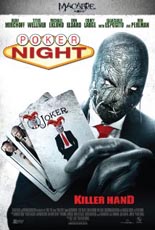
 Take one blind and cranky war veteran, replace “Hoo-ah!” with howls, and you have Late Phases, arguably the best pure werewolf film since 2000’s Ginger Snaps. To be fair, that category is not exactly snapping with fierce competition — Wes Craven’s Cursed, anyone? Thought not! — so let’s broaden the genre and call it a solid suspenser.
Take one blind and cranky war veteran, replace “Hoo-ah!” with howls, and you have Late Phases, arguably the best pure werewolf film since 2000’s Ginger Snaps. To be fair, that category is not exactly snapping with fierce competition — Wes Craven’s Cursed, anyone? Thought not! — so let’s broaden the genre and call it a solid suspenser.
The sight-challenged military man at the center of this hairy tale is Ambrose McKinley (Nick Damici, Stake Land), whose son (Ethan Embry, Cheap Thrills) moves him into the Crescent Bay Retirement Community despite recent reports of residents disappearing. Sure enough, Ambrose barely has time to unpack before his next-door neighbor is mauled to death by a werewolf.
 Well, we know a werewolf is to blame, because director Adrián Garcia Bogliano (Penumbra) lets the viewer in on the claw-gashing action. No one else is privy to the slaughter, yet Ambrose not only somehow surmises the culprit is of the felled-by-silver-bullets variety, but also correctly predicts the next strike will arrive with the following month’s full moon. You can question the “how” all you want; it won’t change a damn thing, so may as well just go with it as Bogliano does.
Well, we know a werewolf is to blame, because director Adrián Garcia Bogliano (Penumbra) lets the viewer in on the claw-gashing action. No one else is privy to the slaughter, yet Ambrose not only somehow surmises the culprit is of the felled-by-silver-bullets variety, but also correctly predicts the next strike will arrive with the following month’s full moon. You can question the “how” all you want; it won’t change a damn thing, so may as well just go with it as Bogliano does.
That you’ll want to speaks to the Spanish filmmaker’s strengths as a director. Late Phases marks his inauguration into English-language features, and he commemorates the challenge by bringing the best of his previous work with him: the mounting tension of 2010’s Cold Sweat and the hallucinatory horror of 2012’s Here Comes the Devil. His eye considerably elevates the so-so script by Eric Stolze, whose 2012’s Under the Bed is as dull as Phases is sharp.
Strangely, its weakest link is the lead performance from Damici, who makes an already crotchety character damn near insufferable — and certainly annoying — by adhering to a needless accent exaggerated to the point of comical: “Those” become “dose”; “thing” becomes “tang.” Good thing his supporting cast is so strong, it truly supports; standouts include Manhunter’s Tom Noonan, Bitch Slap’s Erin Cummings and The Last Starfighter himself, Lance Guest.
The MVP might be David Greathouse (Jug Face), who dons the werewolf suit — that’s right: suit instead of CGI, thereby working wonders in the projection of menace through the screen. The final showdown of man vs. lycanthrope provides much of the movie’s meat; pay particular attention to the 1:15:31 mark, where the beast takes a flying, slow-motion leap toward a car. It’s begging for animated-GIF immortality. —Rod Lott


 Right away, hindsight emerges as the key theme of
Right away, hindsight emerges as the key theme of 





